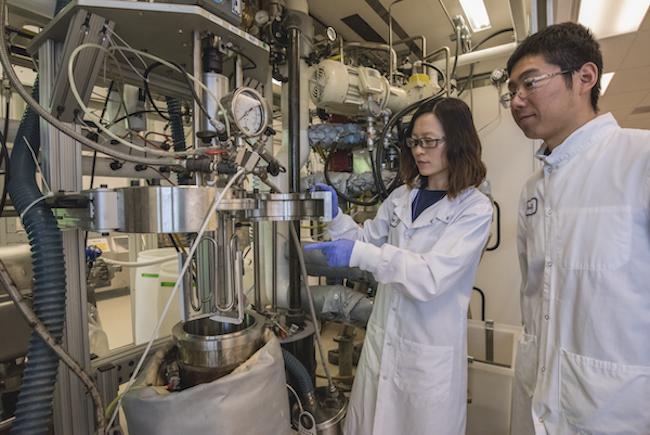
Credit: Marilyn Chung/Berkeley Lab
Trash to Treasure: Scientists Convert Municipal Waste to Biofuel Precursors
By Emily Scott
As the need for energy security grows, scientists are investigating nonfood biomass sources that can be used to create valuable biofuels and bioproducts. Among these sources is municipal solid waste (MSW) — in other words, trash that’s produced every day around the world in significant amounts.
In a new study published in the journal ChemSusChem, researchers at Berkeley Lab created six blends that combined MSW items (non-recyclable paper and grass clippings) with biomass (corn stover and switchgrass). Using an ionic liquid-based process, they converted these blends into methyl ketones, which are chemical compounds that can be used as diesel fuel precursors.
This is the first report on the conversion of MSW to methyl ketones using an ionic liquid process, an efficient biomass pretreatment process that is becoming more sustainable. The research was a collaboration between the Joint BioEnergy Institute and the Advanced Biofuels and Bioproducts Process Development Unit (both established by the Department of Energy and based at Berkeley Lab), where researchers scaled up one of these blends 30-fold and are currently attempting to scale up the process even further.
“The ionic liquid-based conversion represents an efficient and more environmentally friendly process for biomass upgrading,” said Berkeley Lab researcher Ning Sun, the study’s corresponding author. “This opens the door to building biorefinery facilities that use diversified feedstocks to produce a range of chemicals.”
Simple Materials Offer a Peek into the Quantum Realm
By Aliyah Kovner
As reported in Nature Physics, a Berkeley Lab-led team of physicists and materials scientists was the first to unambiguously observe and document the unique optical phenomena that occur in certain types of synthetic materials called moire; superlattices. The new findings will help researchers understand how to better manipulate materials into light emitters with controllable quantum properties.
Moire; superlattices are made by layering sheets of single-atom-thick materials on top of one another in precise configurations to create a larger and more complex overall pattern. In these arrangements, the otherwise simple composite materials display intriguing behavior.
For example, recent studies from the same team showed that moire; superlattices made with three layers of graphene sandwiched in between layers of boron nitride can act as an exotic insulator and a high-temperature superconductor.
In the current study, Berkeley Lab graduate student researcher Emma Regan and her colleagues used two highly sensitive spectroscopy approaches to examine the excitons (bound pairs of electrons and electron-holes, which occur in semiconductive materials) across the layers of a moire; superlattice formed by tungsten disulfide and tungsten diselenide.
“Our work provides needed clarity on how the excitons in moire; superlattices can exist in different states,” said Regan. “And now we know a straightforward way to create perfect arrays of interlayer excitons with distinct optical properties, which can serve as light emitters in next-generation electronic devices.”
Can Cellphones Help Cities Be More Energy Efficient?
By Linda Vu
Buildings currently consume about 40% of all the electricity used in the United States, most of them located in urban areas that are growing rapidly. Because electricity generation is the largest source of greenhouse gas emissions in the country, making urban buildings more energy efficient could help mitigate global climate change.
In order to achieve efficient buildings at a city-wide scale, accurate occupancy estimations are crucial. These estimates need to take into account the fact that people move around their cities throughout the day, from home to work, which drives energy consumption for different building types. Now, a model developed by researchers from Berkeley Lab, UC Berkeley, and MIT can do just that. A paper describing the tool, which uses passively collected cellphone data to improve urban scale building occupancy and mobility estimates, was recently published in Nature Communications.
“Understanding building occupancy at an urban-scale allows us to plan better for collective energy use. Like traffic apps that tell you the current state of road congestion, we envision a model that could potentially tell users what the energy demands are in different places and therefore identify bespoke efficiency measures,” said Berkeley Lab scientist Marta Gonzalez, who is also a UC Berkeley professor of Civil and Environmental Engineering and co-author of the paper. “The tool could also potentially connect to smart-devices that automatically adjust to the energy demand.”
Read the full article from Berkeley Engineering here.
###
Media Contact
Laurel Kellner
[email protected]
510-590-8034




